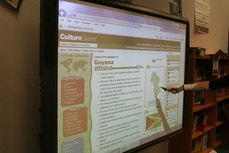3.1 Efficient and ethical information-seeking behavior
Candidates model multiple strategies for students, other teachers, and administrators to locate, evaluate, and ethically use information for specific purposes.
2010 ALA/AASL Standards for Initial Preparation of School Librarians
|
I like to describe my role in the library media center as the Tour Guide to information. Students imitate what they see; modeling is an effective way to teach students and staff how to meet their own information needs. The final assignment to cap the Information Services, Retrieval, Dissemination and Utilization course, SLM 505, was to create a reference website to display “reference bibliography, legal and ethical policies, lesson plan, instructional video, reference advertisements, and links to outside reference sites.” This website brought together all the learning from the course, but also included some of the concepts explored in preliminary courses. The creation of this website allowed me to model information-seeking skills, as well as to publish multiple strategies for students and staff to “locate, evaluate, and ethically use information” themselves.
|
 Photo by Amy Soldavini 2013
Photo by Amy Soldavini 2013
I learned the importance of collaboration and sharing to develop portions of the website. The reference bibliography was created as a group effort, as well as the Freedom to Read, Ethics, Privacy, and Copyright statements. Wordsmithing and revision were important to this process. In the future, I will be running similar items past my professional learning network of fellow school library media specialists – for both revision and sharing. All of my information is properly cited, and I found resources to highlight on the Web site to share how students can also use information ethically. Putting all of the information in one easy to navigate spot can allow me to find specific items when asked a question, but also allows students and staff to browse or return to information when needed later. A goal of the school library media specialist should be to guide students to not just meet their current information needs, but also to nurture a student’s ability to locate, evaluate and ethically use information on their own.
The creation of my collection of tools and resources is a continuous process: updating information and new sources, archiving specific teacher needs for future use, finding new outside sources for school collaboration. Throughout my career I will never be “done” with my website, collection, or ideas. This is one reason my career is always fresh and exciting. The phrase, “model multiple strategies” is so important in the role of the school library media specialist. Rather than becoming the citation police, we can, through modeling, show others how to use information ethically and professionally, yet still be efficient. This ability to locate, evaluate and ethically use information is a skill that creates lifelong learners; it is a skill that can transfer to any information need students encounter in their future.
The creation of my collection of tools and resources is a continuous process: updating information and new sources, archiving specific teacher needs for future use, finding new outside sources for school collaboration. Throughout my career I will never be “done” with my website, collection, or ideas. This is one reason my career is always fresh and exciting. The phrase, “model multiple strategies” is so important in the role of the school library media specialist. Rather than becoming the citation police, we can, through modeling, show others how to use information ethically and professionally, yet still be efficient. This ability to locate, evaluate and ethically use information is a skill that creates lifelong learners; it is a skill that can transfer to any information need students encounter in their future.

This portfolio and the artifacts contained herein by Amy Soldavini are licensed under a Creative Commons Attribution-NonCommercial-ShareAlike 3.0 Unported License |
Revised July 2013
